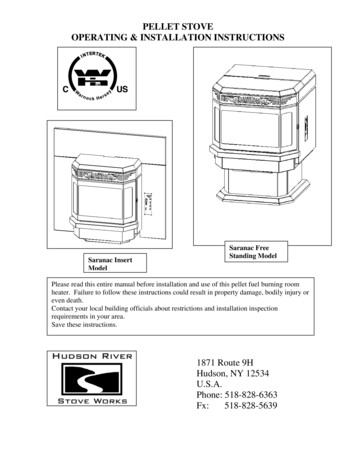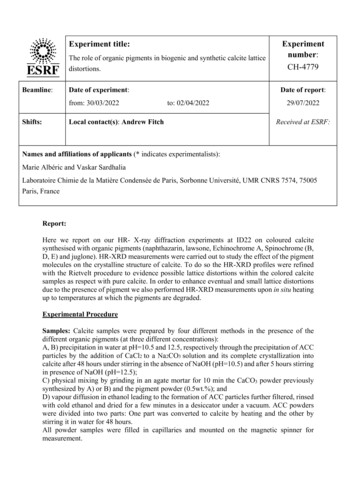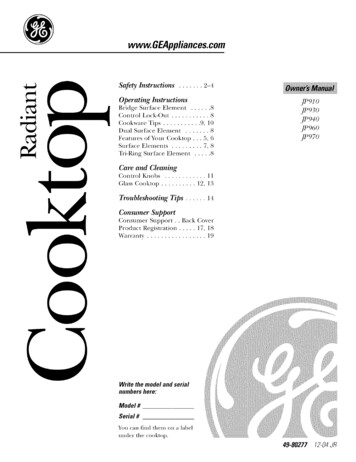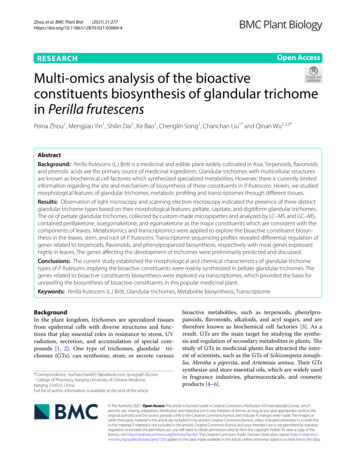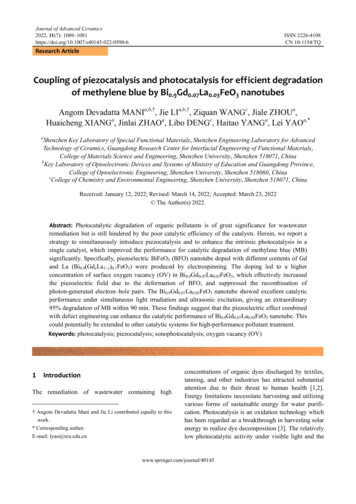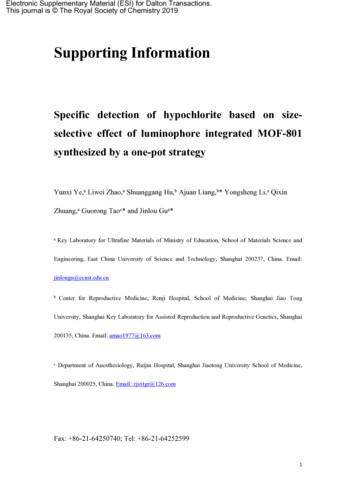
Transcription
Electronic Supplementary Material (ESI) for Dalton Transactions.This journal is The Royal Society of Chemistry 2019Supporting InformationSpecific detection of hypochlorite based on sizeselective effect of luminophore integrated MOF-801synthesized by a one-pot strategyYunxi Ye,a Liwei Zhao,a Shuanggang Hu,b Ajuan Liang,b* Yongsheng Li,a QixinZhuang,a Guorong Taoc* and Jinlou Gua*aKey Laboratory for Ultrafine Materials of Ministry of Education, School of Materials Science andEngineering, East China University of Science and Technology, Shanghai 200237, China. Email:jinlougu@ecust.edu.cnbCenter for Reproductive Medicine, Renji Hospital, School of Medicine, Shanghai Jiao TongUniversity, Shanghai Key Laboratory for Assisted Reproduction and Reproductive Genetics, Shanghai200135, China. Email: amao1977@163.comcDepartment of Anesthesiology, Ruijin Hospital, Shanghai Jiaotong University School of Medicine,Shanghai 200025, China. Email: zjsxtgr@126.comFax: 86-21-64250740; Tel: 86-21-642525991
Fig. S1 Digital photographs of the (a) MOF-801 and (b) AF@MOF-801 NPs.Fig. S2 Digital photographs of AF@MOF-801 NPs with AF/FUM feed ratios of (a)0.024:1, (b) 0.096:1, (c) 0.144:1 and (d) 0.216:1.2
Fig. S3 Digital photographs of (a) RhB@MOF-801 and (b) calcein@MOF-801 NPswith different RhB/FUM feed ratio from 0.024:1 to 0.240:1 and calcein/FUM of0.024:1 to 0.184:1.3
Fig. S4 The fluorescence evolvement curves of AF@MOF-801 NPs with differentAF/FUM feed ratios of (a) from 0.024 :1 to 0.144 :1 and (b) from 0.144 : 1 to 0.264 :1.Fig. S5 The fluorescence photographs of AF@MOF-801 NPs with different AF/FUMfeed ratio from 0.024:1 to 0.262:1. The fluorescence was excited with a UV lamp.4
Fig. S6 The fluorescence evolvement curves of calcein@MOF-801 NPs with differentcalcein/FUM feed ratios of (a) from 0.024:1 to 0.092:1 and (b) from 0.092:1 to0.184:1.Fig. S7 The fluorescence photographs of calcein@MOF-801 NPs with differentcalcein/FUM feed ratio from 0.024:1 to 0.184:1. The fluorescence was excited with aUV lamp.5
Fig. S8 The fluorescence evolvement curves of RhB@MOF-801 NPs with differentRhB/FUM feed ratios of (a) from 0.024:1 to 0.120:1 and (b) from 0.120:1 to 0.240:1.Fig. S9 The fluorescence photographs of RhB@MOF-801 NPs with differentRhB/FUM feed ratio from 0.024:1 to 0.240:1. The fluorescence was excited with aUV lamp.6
Fig. S10 The XRD patterns of AF@MOF-801 NPs with different AF/FUM feedratios from 0.024:1 to 0.264:1.Fig. S11 The XRD patterns of RhB@MOF-801 NPs with different RhB/FUM feedratios from 0.024:1 to 0.240:1.7
Fig. S12 The XRD patterns of calcein@MOF-801 NPs with different calcein/FUMfeed ratios from 0.024:1 to 0.184:1.Fig. S13 The N2 adsorption/desorption isotherms of blank MOF-801, RhB@MOF801, calcein@MOF-801 NPs and AF@MOF-801 NPs recorded at 77 K.8
Table S1. Textural parameters of the synthesized pure MOF-801 NPs, RhB@MOF801 NPs, calcein@MOF-801 NPs and AF@MOF-801 NPs.MaterialsBET surface area(m2 g-1)Total pore volume(cm3 g-1)pure MOF-801 NPs936.70.78RhB@MOF-801 NPs851.50.72calcein@MOF-801 NPs811.50.66AF@MOF-801 NPs870.20.73Fig. S14 The SEM image of RhB@MOF-801 NPs (scale bar: 200 nm). The feed ratioof RhB/FUM was set as 0.120:1.9
Fig. S15 The SEM image of calcein@MOF-801 NPs (scale bar: 200 nm). The feedratio of calcein/FUM was set as 0.092:1.Fig. S16 The UV-vis spectra of the supernatant decanted from AF@MOF-801 NPssuspension after different treatments. The free AF molecule was dissolved in anethanol-water (mass ratio of 5:95) mixture solution.10
Fig. S17 The XRD patterns of AF@MOF-801 NPs before (black) and after treatmentwith water (red), NaClO (blue), HCl (pink) and NaOH (green) solutions for 12 h.Fig. S18 The UV-vis spectra of the RhB@MOF-801 NPs supernatant after treatmentwith water (pink), HCl (red) and NaOH (blue) solutions. Free RhB molecules weredissolved in the ultrapure water.11
Fig. S19 The UV-vis spectra of the calcein@MOF-801 NPs supernatant aftertreatment with water (pink), HCl (red) and NaOH (blue) solutions. Free calceinmolecules were dissolved in the ultrapure water.Fig. S20 The XRD patterns of calcein@MOF-801 NPs before (black) and aftertreatment with water (red), HCl (blue) and NaOH (pink) solutions for 12 h.12
Fig. S21 The XRD patterns of RhB@MOF-801 NPs before (black) and aftertreatment with water (red), HCl (blue) and NaOH (pink) solutions for 12 h.13
The calculation method for the LOD of AF@MOF-801 NPs toward ClO detection inaqueous phase at pH 7.4.Detection Limit 3σ/slope 3 1.18/68.44 0.05172 µMLuminescent spectrum was recorded for the blank sample of AF@MOF-801 NPssuspension. Sample standard deviation of σ for the blank probe without the additionof ClO was calculated to be 1.18 at pH 7.4.Fig. S22 The relation of luminescent intensity against ClO added into AF@MOF801 NPs suspension and their linear fit curve for the estimation of LOD at pH 7.4.14
Scheme S1 Schematic illustration for the quenching mechanism of AF for ClO detection.Fig. S23 The UV-vis spectra of the AF@MOF-801 NPs supernatant upon the additionof DA with its concentration range from 0 to 8 µM at pH 7.4.15
Fig. S24 The cell viability of SMMC-7721 cells incubated with differentconcentrations of the AF@MOF-801 NPs. Untreated control cells were used as areference.Fig. S25 The cell viability of HeLa cells incubated with different concentration of theAF@MOF-801 NPs. Untreated control cells were used as a reference.16
Fig. S26 The flow cytometry histograms of SMMC-7721 cells incubated with theAF@MOF-801 NPs within 0 to 24 h. Untreated control cells were used as a controlgroup.Fig. S27 The flow cytometry histograms of HeLa cells incubated with the AF@MOF801 NPs within 0 to 24 h. Untreated control cells were used as a control group.17
Fig. S28 The concentration-response curve of luminescence decrease of AF@MOF801 NPs in SMMC-7721 cells after 30 min exposure to various concentrations ofClO donors. I was obtained by subtracting the luminescence intensity of controlgroup from the real-time luminescence intensity. Each datum point represents themean of datum from eight wells (n 8) with error bars and the untreated cells wereused as control. The concentration of the AF@MOF-801 NPs probe was set as 50 μgmL-1.18
Fig. S29 The concentration-response curve of luminescence decrease of AF@MOF801 NPs in HeLa cells after 30 min exposure to various concentrations of ClO donors. I was obtained by subtracting the luminescence intensity of controlgroup from the real-time luminescence intensity. Each datum point represents themean of datum from eight wells (n 8) with error bars and the untreated cells wereused as control. The concentration of the AF@MOF-801 NPs probe was set as 50 μgmL-1.19
Fig. 30 The Flow cytometry histograms of the AF@MOF-801 NPs in HeLa cells after30 min exposure to various concentrations of ClO . Untreated cells were used ascontrol. The concentration of the AF@MOF-801 NPs probe was set as 50 μg mL-1.Fig. 31 The CLSM images of HeLa cells cultured at 37 with AF@MOF-801 NPsfor 12 h and then incubated with various concentrations of ClO (scale bar: 50 μm).The concentration of the AF@MOF-801 NPs probe was set as 50 μg mL-1.20
control. The concentration of the AF@MOF-801 NPs probe was set as 50 μg mL-1. Fig. 31 The CLSM images of HeLa cells cultured at 37 with AF@MOF-801 NPs for 12 h and then incubated with various concentrations of ClO (scale bar: 50 μm). The concentration of the AF@MOF-801 NPs probe was set as 50 μg mL-1.


